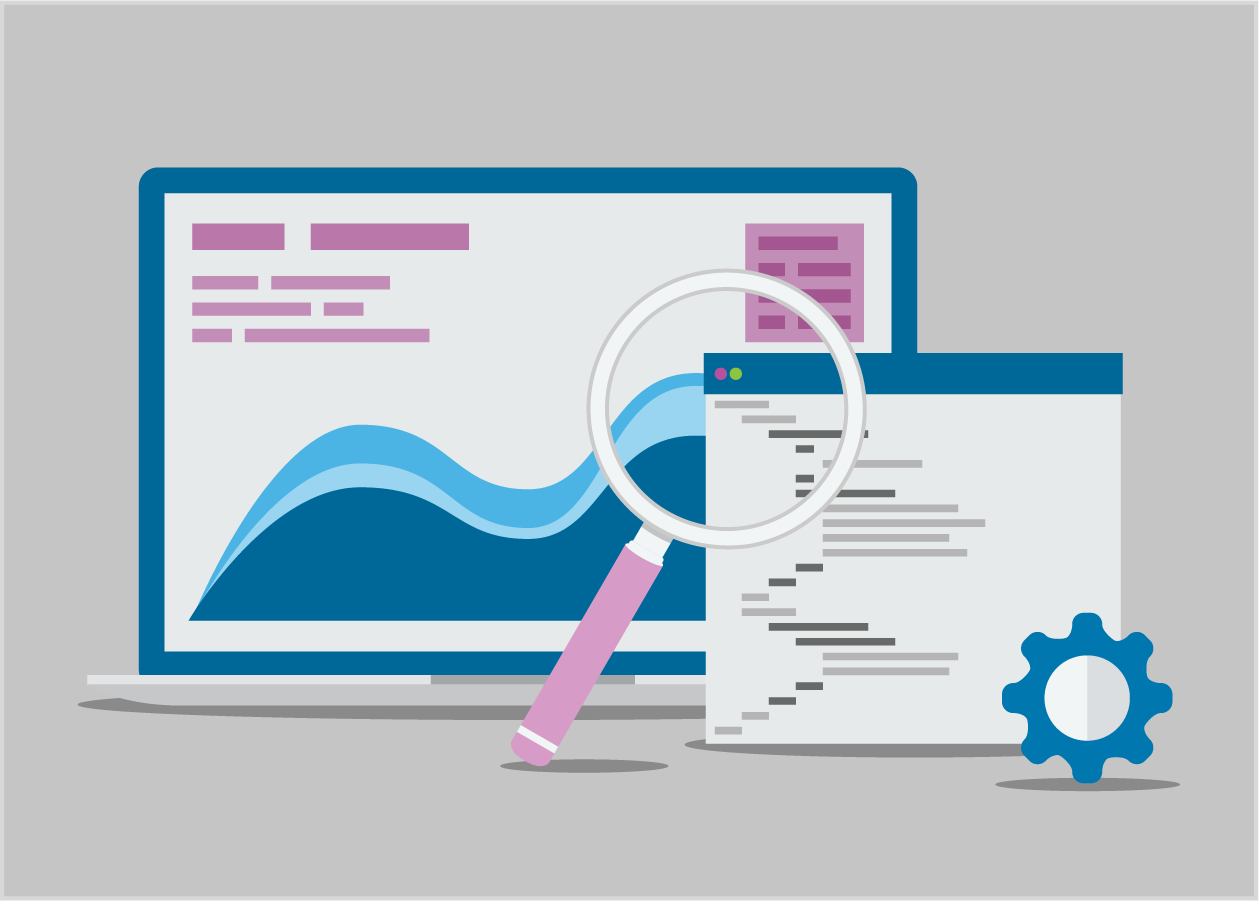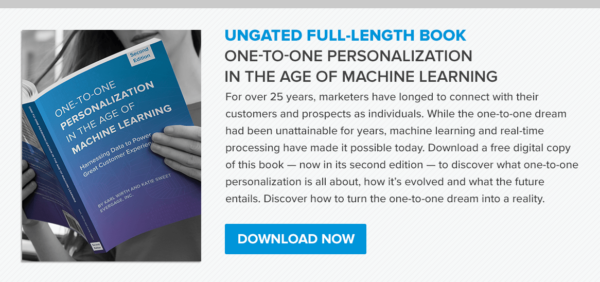Does one size ever really fit all? (The one-size winter sports beanie I got my husband for the holidays barely fit our toddler! Just sayin’…)
This all-encompassing sizing and approach – while hit-or-miss in terms of apparel – is definitely a “miss” when it comes to digital experiences.
Every company has an audience that’s composed of individuals – all with unique preferences, needs, intent, histories and other attributes that necessitate personalized, rather than cookie-cutter, communications to drive genuine engagement.
A Dec. 2019 report from Forrester notes: “Personalization – delivering the right experience to the right customer at the right time – is not easy, but it’s de rigueur for companies that wish to thrive in the age of the customer. … It’s important to remember that customers are individuals that yearn for more personalized interactions. Be equipped to deliver the next-best experience by ingesting signals across the customer journey and tailoring your customer experiences accordingly.”
Looking for more info on why personalization matters – and how and why it works?
The following 30 statistics – including from Forrester and other research firms and organizations – illustrate the power of personalization strategies, approaches and technologies.
Personalization is Top-of-Mind
1. “Personalization” was selected by ANA [Association of National Advertisers] members as the ANA 2019 Marketing Word of the Year. (ANA)
2. 73% of CEOs acknowledge the need for products, services and experiences that are more meaningful to their customers. (Accenture)
3. 74% of marketers think personalization should be a bigger priority in their organizations. (Evergage and Researchscape)
4. 48% of global B2C marketing decision-makers with marketing budget for technology said they would increase their spend on content and personalization technologies in 2019. (Forrester)
Generic Content is a Turn-Off
5. 84% of customers say being treated like a person, not a number, is very important to winning their business. (Salesforce)
6. Nearly three-fourths (74%) of online consumers get frustrated with websites when content (e.g., offers, ads, promotions) appears that has nothing to do with their interests. (Janrain – now Akamai)
7. 63% of consumers expect personalization as a standard of service. (RedPoint Global and Harris Poll)
8. Nearly half (45%) of consumers won’t spend time with branded content if it’s not relevant to their interests. (OneSpot and Marketing Insider Group)
9. 52% of customers are likely to switch brands if a company doesn’t personalize communications to them. Meanwhile, 65% of business buyers say they’re likely to switch brands if a vendor doesn’t personalize communications to their company. (Salesforce)
10. 55% of business buyers (and 54% of consumers) say they get annoyed if they’re targeted for an ad for something they’ve already bought. (Salesforce)
11. Half (50%) of Millennials and Gen Zers say they generally ignore communications from companies unless they’re personalized for them, and 73% expect companies to communicate with them in real time. (Salesforce)
12. 33% of customers who abandoned a business relationship last year did so because personalization was lacking. (Accenture)
Buyers Want (and Expect!) Personalized Experiences
13. 69% of business buyers expect Amazon-like buying experiences – such as personalized recommendations. (Salesforce)
14. 50% of consumers say that they would pay more for products and services from brands that do a good job of providing personally relevant content. (OneSpot and Marketing Insider Group)
15. More than 78% of consumers are only likely to engage with a brand using coupons or other offers if those promotions are directly tied to how they have interacted with the brand previously. (Marketo)
16. 64% of customers expect tailored engagement based on past interactions. (Salesforce)
17. 73% of customers expect companies to understand their needs and expectations. (Salesforce)
18. 62% of customers expect companies to adapt based on their actions and behavior. (Salesforce)
19. 80% of U.S. online adults feel comfortable sharing some personal information with retailers in order to personalize their experience. (Forrester)
20. More than one-third of U.S. online adults want retailers to do more to offer them personalized experiences. (Forrester)
21. 70% of customers say understanding how they use products and services is very important to winning their business. (Salesforce)
Personalization Trends
22. 4 in 10 marketers (40%) employ machine-learning personalization, using artificial intelligence (AI)-based algorithms and predictive analytics to dynamically present recommendations and experiences at the 1-to-1 level. (Evergage and Researchscape)
23. Digital marketers today employ personalization in their emails (78%); on their website (58%); in person, such as through store associates and kiosks (42%), in online advertising (35%); and in their mobile apps (28%) and web apps (19%). (Evergage and Researchscape)
24. Marketers report personalizing content and experiences based on campaign source (49%), pages/content viewed (35%), email opens (34%), products purchased (33%), email clickthroughs (32%), demographics (32%), clicks (30%), geolocation (28%), stage of customer journey (27%) and previous visit behavior (26%). (Evergage and Researchscape)
Personalization Drives Results
25. 90% of marketers report a measurable lift in business results, attributable to personalization, and 58% say that lift is greater than 10%. (Evergage and Researchscape)
26. Nearly all marketers (98%) note that personalization advances their customer relationships – with 7 in 10 (70%) describing the impact as “strong” or “extremely strong.” (Evergage and Researchscape)
27. In 2018, $87.5 billion in sales were influenced by personalized offers that resulted in consumers making a purchase they did not otherwise intend to make. (451 Research)
28. 80% of consumers are more likely to make a purchase when brands offer personalized experiences. (Epsilon)
29. Personalization can deliver five to eight times the ROI on marketing spend and lift sales 10% or more. (McKinsey)
30. Personalized emails generate 6X higher transaction rates. (Experian)
The Evolution of Personalization in Digital Marketing
Personalization in digital marketing has progressed significantly from its early days of broad audience segmentation to today’s sophisticated AI-driven experiences. Initially, marketers focused on basic demographic targeting, such as age, location, and gender, to tailor messages. Over time, advances in technology allowed for more refined approaches, enabling behavioral targeting based on actions, preferences, and browsing history.
Today, personalization has reached a new level, allowing companies to create hyper-targeted, real-time experiences that adapt to customer interactions on the fly. This evolution is driven by the increasing availability of customer data, the rise of machine learning, and advances in predictive analytics. These tools now enable marketers to craft unique, individual journeys for each customer, making personalization a strategic necessity for brands that want to remain competitive in a crowded digital landscape.
Key Milestones in the Evolution of Personalization:
- Early 2000s: Basic demographic segmentation and email personalization based on name and location.
- 2010s: Behavioral targeting based on user actions, including past purchases, browsing behavior, and time spent on pages.
- 2020s and Beyond: Real-time, 1:1 personalization driven by machine learning algorithms and predictive analytics, creating individualized customer experiences.
As brands continue to invest in personalization, they are focusing on providing genuine value to customers by addressing their needs, solving their problems, and building long-term loyalty.
Personalization Technologies: AI and Beyond
As digital marketing demands have grown, so too has the technology supporting personalization.
Artificial intelligence (AI) is at the core of today’s personalization strategies, but it’s only part of the story.
From machine learning algorithms that predict customer preferences to customer data platforms (CDPs) that unify and analyze data in real-time, technology is evolving to meet the demands of ever-more complex personalization.
Key Personalization Technologies:
- Artificial Intelligence (AI): AI powers personalization through sophisticated algorithms that analyze customer data to predict preferences, behaviors, and future needs. It helps marketers deliver content, product recommendations, and offers tailored to individual users, enhancing engagement and conversion rates.
- Machine Learning: Machine learning models continuously analyze user interactions and refine personalization strategies, creating a dynamic loop of customer insights. As these models process more data, they become increasingly effective at predicting what individual users want, improving the relevance of marketing content.
- Predictive Analytics: Predictive analytics uses historical and real-time data to forecast customer behaviors. For example, it can predict which products a customer might purchase next, helping brands target these individuals with highly relevant recommendations and offers.
- Customer Data Platforms (CDPs): CDPs collect and unify customer data from various touchpoints, creating a 360-degree view of each user. These platforms enable seamless personalization by feeding insights back into AI and machine learning models, allowing for real-time customization across channels.
- Natural Language Processing (NLP): NLP enables chatbots, voice assistants, and customer service tools to communicate with customers in a personalized manner. By understanding and interpreting user language, NLP-powered tools can respond to queries and recommend content that meets each user’s specific needs.
- Dynamic Content and Personalization Engines: These tools automatically customize web content, email campaigns, and mobile app experiences based on real-time user data. They adapt the digital environment to each visitor’s preferences and behavior, driving engagement through relevance.
The Future of Personalization Technology
The future of personalization lies in a fully integrated, cross-channel approach where AI-powered tools create cohesive, seamless experiences for customers, regardless of where they interact with a brand. As advancements in big data, machine learning, and IoT (Internet of Things) continue to accelerate, the potential for hyper-personalized, context-driven marketing will only grow.
The ultimate goal?
Meeting customers exactly where they are, in real time, with precisely what they need.
Conclusion
Personalization has come a long way – it’s no longer a nice to have but a must have for today’s customers.
As we’ve seen, personalization in digital marketing isn’t just about tailoring ads or emails; it’s about creating experiences that feel truly relevant to each person. This is all thanks to the power of AI and machine learning which helps brands understand and respond to individual needs in real time.
The result? Customers feel valued and connected to brands in a way that builds loyalty and trust.
For businesses it means meeting customer expectations and standing out in a crowded market. Personalization is all about connections – showing customers you get who they are and what matters to them.

